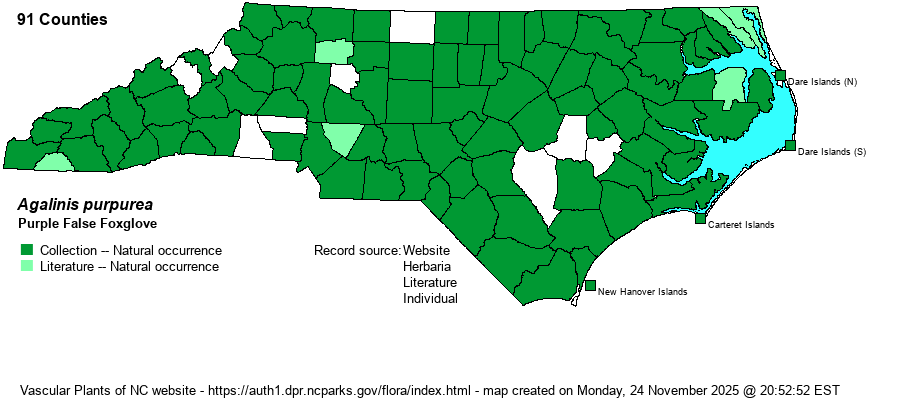| Section 6 » Order Scrophulariales » Family Orobanchaceae |
Show/Hide Synonym
| taxonName | relationship | relatedTaxonName | relatedTaxonRefText | relComments |
|---|
|
|
|
|
|
|
|
|
| Agalinis purpurea | < | Agalinis purpurea var. purpurea | Gleason and Cronquist (1991) | | | Agalinis purpurea | < | Agalinis purpurea var. purpurea | Flora of North America (1993b, 1997, 2000, 2002a, 2002b, 2003a, 2004b, 2005, 2006a, 2006b, 2006c, 2007a, 2009, 2010) | | | Agalinis purpurea | = | Gerardia purpurea var. purpurea | Gleason (1952) | | | Agalinis purpurea | = | Gerardia purpurea | Fernald (1950) | | | Agalinis purpurea | = | Gerardia purpurea | Pennell (1935)=P. | | | Agalinis purpurea | < | Agalinis purpurea | Godfrey and Wooten (1979, 1981) | | | Agalinis purpurea | < | Agalinis purpurea | | | | Source: Weakley's Flora |
|
| Author | (L.) Pennell | |
| Distribution | This is the only statewide Agalinis species, ranging across all parts of the state and likely present in all 100 counties, though currently the map shows a few small holes that likely will be filled by records in time.
This is an Eastern species, ranging from New England south to southern FL and west to central TX. | |
| Abundance | Common over the Coastal Plain and the eastern half of the Piedmont. Fairly common to frequent in the western half of the Piedmont and Mountains. For some unknown reason, there is a scarcity of records for the southwestern Piedmont. | |
| Habitat | This species occurs in a wide array of open habitats, preferably in damp to moist settings. It is not a marsh species, but it grows along marsh edges, ditches, damp fields, powerline clearings, meadows, roadsides, and woodland borders. It does not do well in overly dry soil, but it seemingly can grow almost anywhere in sunny places. |
| Phenology | Blooms in September and October; fruits from October and November. | |
| Identification | This is a very familiar plant across the state, noted often for its hosting caterpillars of Common Buckeyes in the late summer and fall. It is "bushy", growing to about 2-3 feet tall, with numerous wide-spreading branches that are smooth but 4-angled. The numerous opposite leaves are like most others in the genus, being linear but longer than most, about 1.5 inches long, but needle-like. The racemes of bright purple-rose, bell-shaped flowers grow at the ends of the numerous branches; each flower is about 1.5 inches long and nearly as wide at the mouth opening. This is the common species to which all other identification contenders must be compared. A. virgata is similar but it has strongly virgate (upright) branches, yielding a narrow shape to the plant, and it has quite smooth stems; the flowers are somewhat smaller. A. fasciculata also has large rose-colored flowers and is just as tall; however, it also has mostly virgate branches but is easily separated by its numerous short axillary leaves in most or all leaf axils. A. setacea, which also has bright rose-colored flowers, has its flowers on very long pedicels -- over 1-inch long, longer than the calyx tube, whereas the flowers of A. purpurea are on short stalks barely 1/4-inch long. It normally takes little time in much of the state to run into A. purpurea, and it is a quite attractive plant when in bloom in the fall with its abundance of purple-rose flowers. | |
| Taxonomic Comments | Some authors may include varieties for the species, but Weakley (2018) does not.
| |
| Other Common Name(s) | Purple Gerardia, Large-purple False Foxglove | |
| State Rank | S5 | |
| Global Rank | G5 | |
| State Status | | |
| US Status | | |
| USACE-agcp | FACW link |
| USACE-emp | FACW link |

